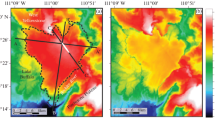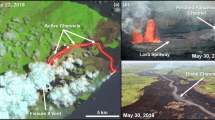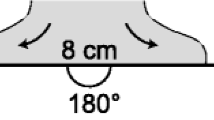Abstract
The 2018 lower East Rift Zone (LERZ) eruption of Kīlauea, Hawai’i, provides an excellent natural laboratory with which to test models of lava flow propagation. During early stages of eruption crises, the most useful lava flow propagation equations utilize readily determined parameters and require fewer a priori assumptions about future behavior of the flow. Here, we leverage the numerous observations of lava flows collected over the duration of the eruption crisis at Kīlauea in 2018 to test simple lava flow propagation models. These models track the one-dimensional propagation of the flows according to three main rheological restraining forces: bulk viscosity, yield strength, and growth of a surface crust. We calculate the predicted changes in length through time of three flows that vary in bulk composition, crystal content, and total flow length. Cooler flows that are more crystal-rich tend to be more dominated by crust growth, though early stages of propagation can be controlled by bulk viscosity. We find that variations in effusion rate significantly impact flows that are short-lived; flows that are produced during steady-state effusion are readily approximated by average values for the entire flow. Thus, accurate knowledge of variations in effusion rate are critical to accurate lava flow propagation forecasting.








Similar content being viewed by others
References
Anderson KR, Poland MP (2016) Bayesian estimation of magma supply, storage, and eruption rates using a multiphysical volcano model: Kīlauea Volcano, 2000–2012. Earth Planet Sci Lett 447:161–171
Anderson KR, Johanson IA, Patrick MR, Gu M, Segall P, Poland MP, Miklius A (2019) Magma reservoir failure and the onset of caldera collapse at Kīlauea Volcano in 2018. Science 366(6470):eaaz1822
Beattie P (1993) Olivine-melt and orthopyroxene-melt equilibria. Contrib Miner Petrol 115(1):103–111
Biren J, Harris A, Tuffen H, Chevrel MO, Gurioli L, Vlastélic I, Schiavi F, Benbakkar M, Fonquernie C, Calabro L (2020) Chemical, Textural and Thermal Analyses of Local Interactions Between Lava Flow and a Tree-Case Study From Pāhoa. Hawai’i. Front Earth Sci 8:233
Bonny E, Wright R (2017) Predicting the end of lava flow-forming eruptions from space. Bull Volcanol 79(7):52
Cashman KV, Kerr RC, Griffiths RW (2006) A laboratory model of surface crust formation and disruption on lava flows through non-uniform channels. Bull Volcanol 68(7–8):753–770
Castruccio A, Rust AC, Sparks RSJ (2013) Evolution of crust-and core-dominated lava flows using scaling analysis. Bull Volcanol 75(1):681
Chevrel MO, Harris A, Ajas A, Biren J, Gurioli L, Calabrò L (2019) Investigating physical and thermal interactions between lava and trees: the case of Kīlauea’s July 1974 flow. Bull Volcanol 81(2):6
Cimarelli C, Costa A, Mueller S, Mader HM (2011) Rheology of magmas with bimodal crystal size and shape distributions: insights from analog experiments. Geochemistry, Geophysics, Geosystems 12:Q07024
Costa A, Caricchi L, Bagdassarov N (2009) A model for the rheology of particle‐bearing suspensions and partially molten rocks. Geochemistry, Geophysics, Geosystems 10:Q03010
De Beni E, Cantarero M, Messina A (2019) UAVs for volcano monitoring: a new approach applied on an active lava flow on Mt. Etna (Italy), during the 27 February–02 March 2017 eruption. J Volcanol Geoth Res 369:250–262
DeSmither LG, Diefenbach AK, Dietterich HR (2021) Unoccupied Aircraft Systems (UAS) video of the 2018 lower East Rift Zone eruption of Kīlauea Volcano, Hawaii. U.S. Geological Survey data release, https://doi.org/10.5066/P9BVENTG
Dietterich HR, Cashman KV (2014) Channel networks within lava flows: formation, evolution, and implications for flow behavior. J Geophys Res Earth Surf 119(8):1704–1724
Dietterich HR, Cashman KV, Rust AC, Lev E (2015) Diverting lava flows in the lab. Nat Geosci 8(7):494–496
Dietterich HR, Lev E, Chen J, Richardson JA, Cashman KV (2017) Benchmarking computational fluid dynamics models of lava flow simulation for hazard assessment, forecasting, and risk management. J Appl Volcanol 6(1):9
Dietterich HR, Diefenbach AK, Soule SA, Zoeller MH, Patrick MP, Major JJ, Lundgren PR (2021) Lava effusion rate evolution and erupted volume during the 2018 Kīlauea lower East Rift Zone eruption. Bull Volcanol 83(4):1–18
Dragoni M (1989) A dynamical model of lava flows cooling by radiation. Bull Volcanol 51(2):88–95
Favalli M, Pareschi MT, Neri A, Isola I (2005) Forecasting lava flow paths by a stochastic approach. Geophys Res Lett 32:L03305
Ferguson DJ, Gonnermann HM, Ruprecht P, Plank T, Hauri EH, Houghton BF, Swanson DA (2016) Magma decompression rates during explosive eruptions of Kīlauea volcano, Hawaii, recorded by melt embayments. Bull Volcanol 78(10):71
Fink JH, Griffiths RW (1992) A laboratory analog study of the surface morphology of lava flows extruded from point and line sources. J Volcanol Geoth Res 54(1–2):19–32
Fink JH, Zimbelman J (1990) Longitudinal variations in rheological properties of lavas: Puu Oo basalt flows, Kilauea Volcano, Hawaii. In Lava Flows and Domes. Springer, Berlin, Heidelberg, pp 157–173
Gansecki C, Lee RL, Shea T, Lundblad SP, Hon K, Parcheta C (2019) The tangled tale of Kīlauea’s 2018 eruption as told by geochemical monitoring. Science 366(6470):eaaz0147
Giordano D, Russell JK, Dingwell DB (2008) Viscosity of magmatic liquids: a model. Earth Planet Sci Lett 271(1–4):123–134
Gonnermann HM, Manga M (2007) The fluid mechanics inside a volcano. Annu Rev Fluid Mech 39:321–356
Griffiths RW (2000) The dynamics of lava flows. Annu Rev Fluid Mech 32(1):477–518
Guest JE, Kilburn CRJ, Pinkerton H, Duncan AM (1987) The evolution of lava flow-fields: observations of the 1981 and 1983 eruptions of Mount Etna Sicily. Bulletin of Volcanology 49(3):527–540
Hamilton CW, Glaze LS, James MR, Baloga SM (2013) Topographic and stochastic influences on pāhoehoe lava lobe emplacement. Bull Volcanol 75(11):756
Hammer JE, Cashman KV, Hoblitt RP, Newman S (1999) Degassing and microlite crystallization during pre-climactic events of the 1991 eruption of Mt. Pinatubo, Philippines. Bulletin of Volcanology 60(5):355–380
Harris AJL, Murray JB, Aries SE, Davies MA, Flynn LP, Wooster MJ, Rothery DA (2000) Effusion rate trends at Etna and Krafla and their implications for eruptive mechanisms. J Volcanol Geoth Res 102(3–4):237–269
Harris AJ, Dehn J, Calvari S (2007) Lava effusion rate definition and measurement: a review. Bull Volcanol 70(1):1
Harris AJ, Rowland SK (2015) FLOWGO 2012: an updated framework for thermorheological simulations of channel-contained lava. Hawaiian Volcanoes: from Source to Surface, Geophysical Monograph Series 208:457–481
Harris AJL, Carn S, Dehn J, Del Negro C, Guđmundsson MT, Cordonnier B, Zakšek K (2016) Conclusion: recommendations and findings of the RED SEED working group. Geological Society, London, Special Publications 426(1):567–648
Houghton BF, Tisdale CM, Llewellin EW, Taddeucci J, Orr TR, Walker BH, Patrick MR (2021a) The birth of a Hawaiian fissure eruption. Journal of Geophysical Research Solid Earth 126:e2020JB020903. https://doi.org/10.1029/2020JB020903
Houghton BF, Cockshell WA, Gregg CE, Walker BH, Kim K, Tisdale CM, Yamashita E (2021b) Land, lava, and disaster create a social dilemma after the 2018 eruption of Kīlauea volcano. Nat Commun 12(1):1–4
Huppert HE (1982a) Flow and instability of a viscous current down a slope. Nature 300(5891):427–429
Huppert HE (1982b) The propagation of two-dimensional and axisymmetric viscous gravity currents over a rigid horizontal surface. J Fluid Mech 121:43–58
HVO Staff (2018). Kīlauea Volcano – 2018 Summit and Lower East Rift Zone (LERZ), Brief Overview of Events April 17 to October 5, 2018. https://volcanoes.usgs.gov/vsc/file_mngr/file-179/Chronology%20of%20events%202018.pdf. Accessed 14 April 2021
Iacovino K, Till CB (2019) DensityX: A program for calculating the densities of magmatic liquids up to 1,627 C and 30 kbar. Volcanica 2(1):1–10
James MR, Carr B, D’Arcy F, Diefenbach A, Dietterich H, Fornaciai A, Smets B (2020) Volcanological applications of unoccupied aircraft systems (UAS): developments, strategies, and future challenges. Volcanica 3(1):67–114
Jones TJ, Llewellin EW (2021) Convective tipping point initiates localization of basaltic fissure eruptions. Earth and Planetary Science Letters 553:116637
Kerr RC, Griffiths RW, Cashman KV (2006) Formation of channelized lava flows on an unconfined slope. J Geophys Res: Solid Earth 111:B10206
Kerr RC, Lyman AW (2007) Importance of surface crust strength during the flow of the 1988–1990 andesite lava of Lonquimay Volcano, Chile. J Geophys Res: Solid Earth 112:B03209
Lev E, Rumpf E, Dietterich H (2019) Analog experiments of lava flow emplacement. Ann Geophys 62(2):VO225
Lister JR (1992) Viscous flows down an inclined plane from point and line sources. J Fluid Mech 242:631–653
Lyman AW, Kerr RC (2006) Effect of surface solidification on the emplacement of lava flows on a slope. J Geophys Res: Solid Earth 111:B05206
Mader HM, Llewellin EW, Mueller SP (2013) The rheology of two-phase magmas: a review and analysis. J Volcanol Geoth Res 257:135–158
Magnall N, James MR, Tuffen H, Vye-Brown C (2017) Emplacing a cooling-limited rhyolite lava flow: similarities with basaltic lava flows. Front Earth Sci 5:44
Manga M, Castro J, Cashman KV, Loewenberg M (1998) Rheology of bubble-bearing magmas. J Volcanol Geoth Res 87(1–4):15–28
Muir DD, Blundy JD, Rust AC (2012) Multiphase petrography of volcanic rocks using element maps: a method applied to Mount St. Helens, 1980–2005. Bulletin of Volcanology 74(5):1101–1120
Neal CA, Brantley SR, Antolik L, Babb JL, Burgess M, Calles K, Dotray P (2019) The 2018 rift eruption and summit collapse of Kīlauea Volcano. Science 363(6425):367–374
Patrick MR, Houghton BF, Anderson KR, Poland MP, Montgomery-Brown E, Johanson I, Elias T (2020) The cascading origin of the 2018 Kīlauea eruption and implications for future forecasting. Nat Commun 11(1):1–13
Patrick MR, Dietterich HR, Lyons JJ, Diefenbach AK, Parcheta C, Anderson KR, Kauahikaua JP (2019) Cyclic lava effusion during the 2018 eruption of Kīlauea Volcano. Science 366(6470):eaay9070
Patrick M, Orr T, Fisher G, Trusdell F, Kauahikaua J (2017) Thermal mapping of a pāhoehoe lava flow, Kīlauea Volcano. J Volcanol Geoth Res 332:71–87
Pinkerton H, Stevenson RJ (1992) Methods of determining the rheological properties of magmas at sub-liquidus temperatures. J Volcanol Geoth Res 53(1–4):47–66
Plank S, Massimetti F, Soldati A, Hess KU, Nolde M, Martinis S, Dingwell DB (2021) Estimates of lava discharge rate of 2018 Kīlauea Volcano, Hawaiʻi eruption using multi-sensor satellite and laboratory measurements. Int J Remote Sens 42(4):1492–1511
Richardson P, Karlstrom L (2019) The multi-scale influence of topography on lava flow morphology. Bull Volcanol 81(4):1–17
Robert B, Harris A, Gurioli L, Médard E, Sehlke A, Whittington A (2014) Textural and rheological evolution of basalt flowing down a lava channel. Bull Volcanol 76(6):824
Roman DC, Soldati A, Dingwell DB, Houghton BF, Shiro BR (2021) Earthquakes indicated magma viscosity during Kīlauea’s 2018 eruption. Nature 592:237–241
Rowland SK, Walker GP (1990) Pahoehoe and aa in Hawaii: volumetric flow rate controls the lava structure. Bull Volcanol 52(8):615–628
Rumpf ME, Lev E, Wysocki R (2018) The influence of topographic roughness on lava flow emplacement. Bull Volcanol 80(7):63
Rust AC, Manga M (2002) Effects of bubble deformation on the viscosity of dilute suspensions. J Nonnewton Fluid Mech 104(1):53–63
Seaman C, Sherman SB, Garcia MO, Baker MB, Balta B, Stolper E (2004) Volatiles in glasses from the HSDP2 drill core. Geochemistry, Geophysics, Geosystems 5:Q09G16
Shea T, Houghton BF, Gurioli L, Cashman KV, Hammer JE, Hobden BJ (2010) Textural studies of vesicles in volcanic rocks: an integrated methodology. J Volcanol Geoth Res 190(3–4):271–289
Soldati A, Farrell JA, Sant C, Wysocki R, Karson JA (2020) The effect of bubbles on the rheology of basaltic lava flows: insights from large-scale two-phase experiments. Earth and Planetary Science Letters 548:116504
Soldati A, Houghton BF, Dingwell DB (2021) A lower bound on the rheological evolution of magmatic liquids during the 2018 Kilauea eruption. Chemical Geology 576:120272
Takagi D, Huppert HE (2010) Initial advance of long lava flows in open channels. J Volcanol Geoth Res 195(2–4):121–126
Tarquini S, de’ MichieliVitturi M (2014) Influence of fluctuating supply on the emplacement dynamics of channelized lava flows. Bull Volcanol 76(3):1–13
Turner NR, Perroy RL, Hon K (2017) Lava flow hazard prediction and monitoring with UAS: a case study from the 2014–2015 Pāhoa lava flow crisis Hawai ’i. J Appl Volcanol 6(1):1–11
Wadge G (1981) The variation of magma discharge during basaltic eruptions. J Volcanol Geoth Res 11(2–4):139–168
Walker GPL, Huntingdon AT, Sanders AT, Dinsdale JL (1973) Lengths of lava flows. Philos Trans Royal Soc Lond Ser A Math Phys Sci 274(1238):107–118
Williams RS, Moore JG (1983) Man against volcano: the eruption on Heimaey, Vestmannaeyjar, Iceland. US Geological Survey General Interest Publication 1–27
Zoeller MH, Patrick MR, Neal CA (2018) Crisis remote sensing during the 2018 lower East Rift Zone eruption of Kīlauea Volcano. Photogramm Eng Remote Sens 84(12):749–751
Acknowledgements
The authors would like to thank B. Omori for providing imagery of the eruption, and the HVO staff and eruption response team for providing eruption imagery and samples. We thank Ormat Technologies, Inc., for the use of their pre-eruption lidar DEM in our estimation of F17 flow thickness. This manuscript was improved by QGIS assistance from S. Rowland, image processing assistance from A. Marshall, and discussions with J. Allen and B. Houghton. Thoughtful reviews from E. Lev, M.E. Rumpf, and an anonymous reviewer greatly refined the ideas in this manuscript. We also thank G. Waite for swift editorial handling. Any use of trade, firm, or product names is for descriptive purposes only and does not imply endorsement by the U.S. Government. This is SOEST contribution #11395.
Funding
This study was funded by the Donald Swanson Graduate Research Fellowship, administered by the University of Hawai’i at Mānoa, awarded to R.D., and National Science Foundation RAPID award #1838502 to J.H. and T.S. Instrumentation used to collect data was purchased via National Science Foundation awards #1839095 and #1828799 to R.P.
Author information
Authors and Affiliations
Corresponding author
Additional information
Editorial responsibility: G.P. Waite
This paper constitutes part of a topical collection:
The historic events at Kilauea Volcano in 2018: summit collapse, rift zone eruption, and Mw6.9 earthquake
Supplementary Information
Below is the link to the electronic supplementary material.
Rights and permissions
About this article
Cite this article
deGraffenried, R., Hammer, J., Dietterich, H. et al. Evaluating lava flow propagation models with a case study from the 2018 eruption of Kīlauea Volcano, Hawai'i. Bull Volcanol 83, 65 (2021). https://doi.org/10.1007/s00445-021-01492-x
Received:
Accepted:
Published:
DOI: https://doi.org/10.1007/s00445-021-01492-x




